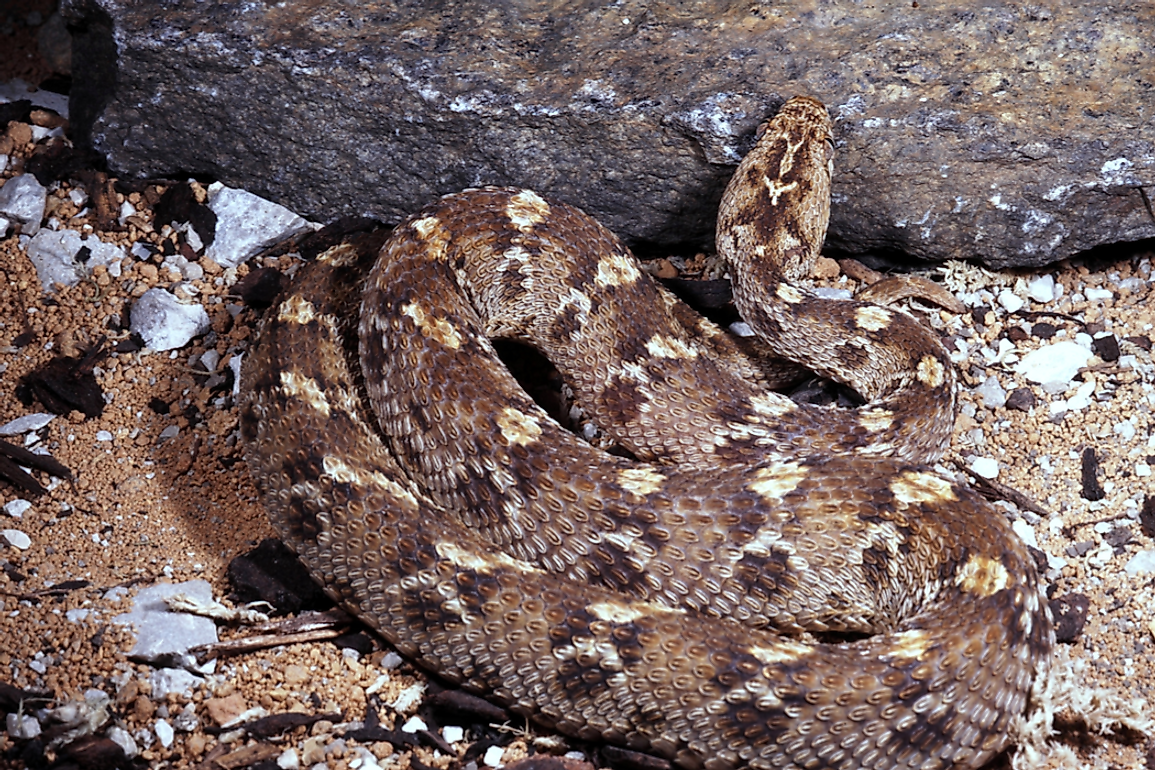The Most Venomous Snakes Of Egypt

Several species of snakes are found in Egypt, both venomous and non-venomous. Snakes in Egypt are found in a wide variety of habitats ranging from the vast sandy deserts to the fertile Nile delta. Snakes play an important role in Egyptian mythology and are both revered and feared by the Egyptians. Here is a list of the most venomous snakes of Egypt.
9. Black Desert Cobra
One of the most venomous snakes found in Egypt and other parts of the Middle East, the Walterinnesia aegyptia is completely black in color and has shiny scales. The average length of this species is 0.5 m. As the name suggests, these snakes inhabit desert habitats but only those areas that have some volume of vegetation and a rocky terrain. They avoid completely sandy deserts. The black desert cobra also tends to live near human settlements where easy sources of prey exist. Lizards, rodents, and birds constitute the prey base of these snakes. The potent venom of the snake is primarily neurotoxic in nature.
8. Red Spitting Cobra
The Naja pallida is another species of elapid that is found in Egypt. The snake has lengths ranging from 0.7 to 1.2 m. Although the color of the snake varies in different parts of its range in Africa, it is usually bright salmon-red in color and has a broad black band on the throat. The snake prefers to live in the semi-desert and dry savanna habitats in Egypt. The agile snakes are nocturnal and terrestrial by nature. They often exhibit cannibalistic behavior. Amphibians are their preferred prey but birds and rodents are also preyed upon by these snakes. The red spitting cobra spits venom in the eyes of the intruder that it believes is a threat to its life. The venom which is a mixture of cytotoxins and neurotoxins can lead to extreme pain and even the permanent loss of eyesight.
7. Egyptian Cobra
The Naja haje, an African species of cobra, is the second largest cobra species on the continent. The length of the snake ranges between 1 and 2 m. The color varies distinctly in different parts of the range of this species. However, most specimens have a brownish color. The species has a widespread range that covers North Africa north of the Sahara, and parts of eastern and western Africa. These snakes are highly adaptable and can live in a wide variety of habitats. They also co-exist with humans where they find easy prey in the form of rodents, chickens, and other smaller animals. The snake is a nocturnal and crepuscular species. The Egyptian cobra’s venom is highly toxic. It is a potent mixture of neurotoxins and cytotoxins. Deaths after envenomation in the victim are usually due to complete respiratory failure triggered by the effect of the neurotoxins present in the venom. The Egyptian cobra played an important role in Egyptian mythology and some believe that Cleopatra committed suicide by getting herself intentionally bitten by this snake.
6. Painted Saw-scaled Viper
The Echis coloratus is a venomous species belonging to the Viperidae family. It is endemic to Egypt and other parts of the Middle East. It lives in rocky desert areas and is found at altitudes up to 2,500 m from sea level. The maximum length attained by the species is around 75 cm.
5. Egyptian Carpet Viper
The Echis pyramidum is another species of the Echis genus that is found only in parts of Northeast Africa and the Arabian Peninsula. Thus, Egypt is a part of the range of this species. The snake has a body size ranging from 30 to 60 cm.
4. Indian Saw-scaled Viper
The Echis carinatus has a wide range of distribution from the Middle East to the Indian sub-continent. It is responsible for a significant number of snakebite fatalities in areas where it occurs, a fact which could be attributed to the snake’s unpredictable nature and tendency to live in areas populated by humans. The size of the snake ranges from 38 to 80 cm. The body color is highly variable from grayish to reddish to brownish. The E. carinatus inhabits a wide variety of landscapes ranging from rocky to sandy. The snake is nocturnal and crepuscular in nature. It feeds on amphibians, insects, arachnids, rodents, etc.
3. Sahara Sand Viper
Cerastes vipera is a member of the Viperidae that lives only in the North African deserts and the Sinai Peninsula. Egypt is thus part of its range. The snake has an average length of about 20 to 35 cm.
2. Field's Horned Viper
The Pseudocerastes persicus fieldi is a subspecies of the Pseudocerastes persicus that is endemic to the Middle Eastern deserts. Although most vipers have venom with cytotoxic components, the venom of the Field's horned viper has distinct neurotoxic effects. An antivenin for bites of this subspecies does not exist and although it is possible to protect the bitten victim against the cytotoxins present in the venom, effective ways to neutralize the effect of the neurotoxic components has not yet been devised.
1. Saharan Horned Viper
The Cerastes cerastes is a member of the Viperidae whose range includes the deserts of the Middle East and North Africa. Most specimens have a pair of supraorbital "horns". The length of the body varies from 30 to 60 cm. These snakes survive in extreme habitats and are found in arid sandy areas with scattered rocks. Unlike most other venomous snakes of Egypt, the venom of this species is less toxic. 40 to 50 mg of the dry weight of the venom would, however, kill a human.







